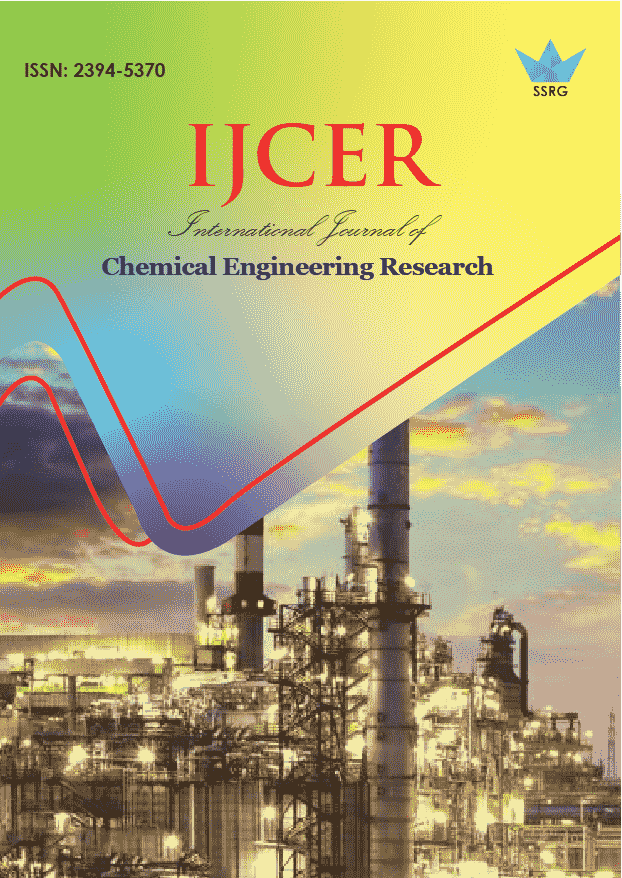Production of Bio-Fuel and Furniture Products Using Water Hyacinth

| International Journal of Chemical Engineering Research |
| © 2014 by SSRG - IJCER Journal |
| Volume 1 Issue 1 |
| Year of Publication : 2014 |
| Authors : Dr.R.Suganeshwari, K.Ramani |
How to Cite?
Dr.R.Suganeshwari, K.Ramani, "Production of Bio-Fuel and Furniture Products Using Water Hyacinth," SSRG International Journal of Chemical Engineering Research, vol. 1, no. 1, pp. 13-15, 2014. Crossref, https://doi.org/10.14445/23945370/IJCER-V1I1P105
Abstract:
This paper discuss about the production of bio fuel by using the aquatic plant which will available in the North America. In this process the it will produced the bio fuel which the renewable resources. The pretreatement process that requires the chemical will make the process a much costlier. The bio fuel from the non aquatic plant will be used for the different uses this will not produce any adverse effects to the environment or any other natural resources. The main concept of aquatic energy is to convert energy in the tropical and sub tropical région. In this it will also used to produce the luxurious furnitures and other materials. The water hyacinth can be used for the many other purposes.
Keywords:
Bio-Gas, non-renewable resources
References:
[1] J. Sheehan, V. Camobreco, J. Duffield, M. Graboski, and H. Shapouri, Life cycle inventory of biodiesel and petroleum diesel for use in an urban bus, final report for U.S. Dept. of Energy’s Office of Fuel Development and the U.S. Dept. of Agriculture’s Office of Energy, by the National Renewable Energy Laboratory, NREL/ SR – 580- 24089 (May 1998).
[2] Knothe G, Dunn RO, Bagby MO (1997) Biodiesel: the use of vegetable oils and their derivatives as alternative diesel fuels. In: Fuels and Chemicals from Biomass, 1st edn. American Chemical Society, New York.
[3] Chanakya, H.N., Borgaonkar, S., Meena, G., Jagadish, K.S. 1993. Solid-phase biogas production with garbage or water hyacinth. Bioresour. Technol. 46, 227-231.
[4] Bergier, I., Ishii, I.H., Salis, S.M., Pellegrin, L.A., Resende, E.K., Tomas, W.M., Soares, M.T.S. 2008. Cenários de desenvolvimento sustentável no Pantanal em função de tendências hidroclimáticas. Série Documentos. Corumbá . MS. Embrapa Pantanal, p.1-21. Available via EMBRAPA. http://www.cpap.embrapa.br/publicacoes/online/DOC98.pdf. Accessed 11 May, 2010.
[5] Gunnarsson CC, Petersen CM (2007) Water hyacinths as a resource in agriculture and energy production: A literature review. Waste Man 27: 117-129.
[6] Delucchi, M.A. 2006. Life cycle analysis of biofuels. Draft Manuscript, Davis, CA, ITS, University of California at Davis. Available via UCDAVIS. http://www.its.ucdavis.edu/publications/2006/UCD-ITS-RR-06-08.pdf. Accessed 11 May, 2010.
[7] Duke, J.A. 1983. Handbook of energy crops. Unpublished. Available via PURDUE. http://www.hort.purdue. edu/newcrop/duke_energy/Eichornia_crassipes.html. Accessed 11 May, 2010.
[8] Liebmann, B., Vera, C.S., Carvalho, L.M.V., Camil-loni, I.A., Hoerling, M.P., Allured, D., Barros, V.R., Baez, J., Bidegain, M. 2004. An observed trend in central South American precipitation. J. Clim.17, 4357-4367.
[9] Malik, A. 2007. Environmental challenge vis a vis oppor-tunity: the case of water hyacinth.Environ. Internat. 33, 122-138.
[10] Makkar, H. P. S. , K. Becker and B. Schmook, Edible provenances of Jatropha curcas from Quintana Roo state of Mexico and effect of roasting on antinutrient and toxic factors in seeds. In: “Plant Food for Human Nutrition”, Springer Netherlands, Volume 52, Number 1, March 1998.
[11] Mathews, John, A Biofuels Manifesto: Why biofuels industry creation n should be “Priority Number One” for the World Bank and for developing countries. Macquarie Graduate School of Management Macquarie University, Sydney, Australia,September 2006.
[12] Osterkorn, Marianne, Ethanol in Africa – Nigeria Will Use Brazilian Blueprint for Its New Biofuels Industry.EcoWorld, July 2006. (http://www.ecoworld.com/home/articles2.cfm?ti=389)

 10.14445/23945370/IJCER-V1I1P105
10.14445/23945370/IJCER-V1I1P105